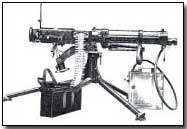The War in the Air - Fighters: Early Experimentation
 In November of 1912 the Vickers company received a contract for an
experimental airplane to be armed with a
machine gun. Vickers' response was the "Experimental
Fighting Biplane 1" - nicknamed "Destroyer".
In November of 1912 the Vickers company received a contract for an
experimental airplane to be armed with a
machine gun. Vickers' response was the "Experimental
Fighting Biplane 1" - nicknamed "Destroyer".
The EFB1 had a crew consisting of a pilot and a gunner. Vickers chose a pusher layout as it allowed them to place the gunner forward of the pilot with an uninterrupted field of fire ahead of the aircraft. It was armed with a single 0.303-in Maxim machine gun on a swivel mount. The weight of the Maxim made the EFB1 nose heavy, and it crashed on its first flight with the gun in place.
While the government gave Vickers further contracts to continue development, the concept of a fighting aircraft remained an esoteric experiment.
In the first weeks of the war the pilots and observers went up unarmed, and often would wave to one another if their paths crossed. But fairly quickly they began experimenting with means of attacking one another. Pistols and rifles proved to be ineffective, as did some of the more bizarre attempts such as throwing bricks, and trailing bombs or grappling irons behind the plane.
By October of 1914 many pilots were experimenting with machine guns. Louis Strange improvised a safety strap allowing the observer of his tractor driven Avro 504 to "stand up and fire all round over top of plane and behind". On the 5th of October 1914 a French Voisin III two-seater pusher biplane became the first plane to shoot down another when it encountered an Aviatik B.1. The shots were fired by the observer who stood up in order to fire a Hotchkiss machine gun.
Early 1915 saw pilots still attempting to find a practical technique. The first Vickers FB5 "Gunbus" aircraft, an evolution of the "Destroyer", had arrived on the Western front by February, but it did not meet with much success. Aiming a machine gun from one plane moving in three dimensions, to fight another plane moving in three dimensions, was extremely difficult.
Moreover, the pusher FB5 was not fast enough, or nimble enough, to be an effective fighter. The perfect configuration, the pilots began to understand, would be a more manoeuvrable tractor aircraft. A fixed machine gun pointing forward would allow the attacking pilot to aim the entire aircraft. This would be easier than aiming a free-swinging machine gun as on the Gunbus, and would eliminate the need for an observer, making the aircraft smaller and lighter. The machine gun should be located close to the pilot to allow him to reload and service the gun should it jam.
There was only one problem with this configuration: the propeller.
Louis Strange experimented with a solution using a Martinsyde S I biplane. He fixed a Lewis gun on top of the upper wing, high enough to clear the airscrew. While this seemed quite a good solution, it introduced new problems, as Strange himself discovered on the 10th of May while attempting to shoot down an Aviatik. After firing off a whole drum from his Lewis gun he broke off in order to reload.
Unfortunately the drum jammed, and Strange stood up on his seat in order to try and pry it loose. The plane stalled, flipped over, and began to spin earthwards upside-down. Strange was flung out of the plane, and found himself dangling below the upper wing, hanging on by the very drum he had been trying to shake loose.
By swinging his legs wildly he managed to get a foothold inside the cockpit and drag himself back inside in time to right the plane and avoid a crash. In his wild thrashing he had smashed all the dials in his instrument panel and broken the seat.
(Despite such antics Strange was to survive the war, finishing the war as a Wing Commander. In the Second World War he flew in the volunteer reserve, and set up both the airborne forces parachute training course, and the fighter convoy defence unit.)
Article contributed by Ari Unikoski
Next - Fighters - Deflector and Interrupter: The Birth of the Fighter
A 'Toasting Fork' was a bayonet, often used for the named purpose.
- Did you know?
